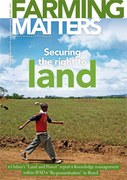“Investments” in southern India have very negative consequences, says Suprabha Seshan. “In my immediate neighbourhood, a tea farm sells at 1 million rupees an acre. A few years ago it would have been a fifth of this price. Of course this means that rural people are leaving the countryside. They are leaving independent and stable (though, not easy) lives to become consumers in the shanty towns around cities.”
Farming Matters | 27.4 | December 2011
I am witness to the butchery of land, habitat, indigenous communities and traditional farming systems in the Western Ghats, a large mountain range in south-west India. This butchery accompanies another hideous process: amalgamation and theft.
A couple of centuries ago, the Western Ghats were the home of hill tribes, vast forests, abundant wildlife and sparkling rivers. The various petty kingdoms in the plains had little to do with these remote areas, other than occasional skirmishes with the more warlike tribes, seasonal exchanges of produce and pilgrim visits to holy rivers and sacred forests. Colonial rulers – the predecessors to the neoliberal (or “neo-colonial”) commodification forces currently at work – were the first to see “opportunity” in these high mountains. Over time, several massive transformations in land use patterns have taken place, not to mention ecological changes at landscape level with grievous consequences for all.
The mountains are now the destination of world tour operators. They are also being gobbled up by movie stars, politicians, resorts, back-to-nature urbanites, and a land mafia indulging in speculation with land as their currency, in a violent, turbulent and corrupt marketplace. In addition, they are being urbanised.
I’ve been living here for 20 years, in these once beautiful mountains. Butchery (in its current avatar) arrived after I did, after wildlife tourism, ecotourism, and plantation tourism. Tourism arrived with the crash of small-scale and cash crop farming and the abandonment of government-controlled pricing of farm products. It brought the corporate nouveau riche to their own “backyard” wildernesses, for weekend outings to “commune with nature”.
A couple of years ago I started enquiring about the activities of the sub-registrar offices where land is transferred between buyer and seller. I found that each of the seven sub-registrar offices in Wayanad district (about 2500 km² in size) dealt with several thousand transfers a year: each year the number of transactions grew, each time the pieces became smaller and smaller – and each time the prices skyrocketed. Every now and again, they would be amalgamated into one big transaction by a massive hotel, a movie star or a politician.
Now, in my immediate neighbourhood, a tea farm sells at 1 million rupees an acre. A few years ago it would have been a fifth of this price. Of course this means that rural people are leaving the countryside. They are leaving independent and stable (though, not easy) lives to become consumers in the shanty towns around cities.
Who does this serve? What happens when you break the relationship between people and land, when small-scale farmers or adivasis become dependant on the state for food and water?
Text: Suprabha Seshan
Suprabha Seshan is an ecologist and educator at the Gurukula Botanical Sanctuary, a forest garden in the Western Ghat mountains of Kerala, India, dedicated to the preservation of plant species, restoration ecology, and environmental education.
E-mail: jungler@gmail.com

